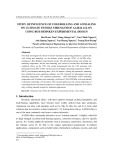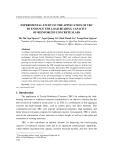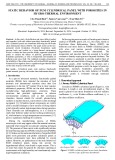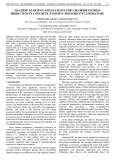
* Corresponding author. Tel. & Fax.: +98 7433221711
E-mail addresses: m.zamani.n@gmail.com m_zamani@yu.ac.ir (M. Zamani Nejad)
© 2016 Growing Science Ltd. All rights reserved.
doi: 10.5267/j.esm.2016.6.001
Engineering Solid Mechanics4 (2016) 201-218
Contents lists available at GrowingScience
Engineering Solid Mechanics
homepage: www.GrowingScience.com/esm
An effective combination of finite element and differential quadrature method for
analyzing of plates partially resting on elastic foundation
Mehdi Dehghan, Mohammad Zamani Nejad* and Amin Moosaie
Mechanical Engineering Department, Yasouj University, P. O. Box: 75914-353, Yasouj, Iran
A R T I C L EI N F O A B S T R A C T
Article history:
Received 6 March, 2016
Accepted 23 June 2016
Available online
23 June 2016
This paper is concerned with the vibration and stability analysis of thick rectangular plates
resting on elastic foundation, which is distributed over the particular area of the plate. A two-
parameter (Pasternak) model is considered to describe the elastic foundation. The eigenvalue
problem in 3-D domain is numerically solved by a combination of the finite element and
differential quadrature method (DQM). The energy principle is employed to derive the
governing equations in the framework of three-dimensional, linear and small strain theory of
elasticity. The in-plane domain of the problem is discretized using two-dimensional finite
elements and spatial derivatives of equations in the thickness direction are discretized in strong-
form using DQM. As a first endeavor, the mixed FE-DQ method has been employed for 3-D
buckling and free vibration analysis of rectangular thick plates partially supported by an elastic
foundation. The accuracy of obtained results is validated by comparing to the few analytical
solutions in the literature.
© 2016 Growin
g
Science Ltd. All ri
g
hts reserved.
Keywords:
FE-DQ method
Stability and free vibration
Thick plates
Partial elastic foundation
1. Introduction
The vibration of plates resting on elastic foundations, which has practical applications in civil,
mechanical, marine and aerospace engineering, has been investigated extensively. In addition, various
analytical and numerical methods have been employed to study this problem. Generally, a lot of
engineering problems can be modeled as thick plates on elastic foundations such as footings and raft
foundations of variety of structures, pavement of roads and bases of heavy machines. It should be noted
that, the mechanical behavior of elastic foundations was widely discussed by Winkler (1867) and
Pasternak (1954) (as a two-parameter model). Different two-dimensional and three-dimensional
theories by numerical or analytical methods can be used to analyze the plates on elastic foundations.
The two-dimensional plate theories including classical plate theory (CPT), the first order shear

202
deformation plate theory (FSDT) and the higher order shear deformation plate theories (HSDT) are
commonly used for the analysis of plates. The classical plate theory (Timoshenko and Woinowsky-
Krieger, 1970) assumes that the straight lines, initially normal to the mid-plane, remain straight and
normal to the mid-plane during the deformation (known as Kirchhoff hypotheses). This means that the
vertical shear strains are negligible. The thin plate theories are assumed in which the reaction forces of
elastic foundation are acting on middle surface of plates (Leissa, 1973), whereas in thick plate analysis,
the effects of elastic foundation on the upper and lower surfaces of the plates are obviously different.
In first-order shear deformation theory, a constant shear strain distribution is considered through the
thickness of the plates (Mindlin, 1951). A correction factor is then introduced to reduce the errors
resulting from this hypothesis. The higher-order shear deformation theory is then proposed to represent
better the shear stress distribution along the thickness direction. It should be mentioned that the inherent
deficiency is unavoidable in these approximate theories because the transverse normal stress is not
considered (Lim, 1999).
Despite the 2-D analysis, a three dimensional analysis does not rely on any assumption about
kinematics of deformation of a plate. Consequently, such analyses not only provide more realistic
results but also reveal physical characteristics which cannot otherwise be predicted by 2-D analysis.
Takahashi and Sonoda (1992) presented results for buckling and free vibration of thin plates on elastic
foundation. The free vibration and buckling analysis of rectangular Mindlin plate on elastic foundation
with simply supported boundary condition was performed by Xiang et al. (1994). The finite element
method was employed by Omurag et al. (1997) for free vibration analysis of thin plates on elastic
foundation. Lam et al. (2000) used Green functions to study the bending, buckling and free vibration
of Levy plates on elastic foundation. The higher-order shear deformation theory using power expanded
series was used by Matsunaga (2000), for three-dimensional analyses of thick plates on elastic
foundation. Thereafter, the vibration behavior of rectangular Mindlin plates resting on non-
homogenous elastic foundation was studied in detail (Xiang, 2003).
The Ritz method was used by Zhou et al. (2004) for free vibration analysis of thick rectangular
plates based on three-dimensional theory of elasticity. The partially supported assumption regarding
free vibration analysis of thin rectangular plates has been suggested by Motaghian et al. (2012). Lately,
in analyzing of thin plates resting on elastic foundation, the innovative superposition method base on
Hamiltonian system has been presented by Pana et al. (2013). The refined shear deformation theory has
been proposed by Thai et.al (2013) for bending, buckling, and vibration of plates on elastic foundation.
This theory is based on assumption that the in-plane and transverse displacements consist of bending
and shear components. This theory does not require shear correction factor and has strong similarities
with CPT in some aspects. Use of shear forces instead of rotational displacements has been suggested
by Thai and Choi (2014) as zeroth-order shear deformation theory for bending and vibration analyses
of functionally graded plates resting on elastic foundation.
Samaei et al. (2015) derived an explicit solution for obtaining the natural frequencies of the graphene
sheet embedded in elastic medium using nonlocal Mindlin plate theory. The finite element method was
used by Vimal et al. (2014) to study the free vibration analysis of functionally graded skew plates.
Initially, Bellman et al. (1972) proposed the DQ method as a simple and rapid solution method to solve
nonlinear partial differential equations. The Generalized Differential Quadrature (GDQ) method was
implemented to analyze some structural problems by Du et al. (1994). Thereafter, the GDQ method has
been widely used to carry out three-dimensional analyses of rectangular plates (Liew, 1998, 1999, Teo,
1999). Recently, The Differential Quadrature Method (DQM) has been used for free vibration analysis
of nonhomogeneous orthotropic rectangular plate resting on elastic foundation (Gupta et al., 2016).
Previously, the FE-DQ method has been used to analyze the free vibration and buckling of thick plates
(Dehghan and Baradaran, 2011).
Observation from the literature listed above and to the best of author’s knowledge indicates that,
the 3-D buckling and free vibration analysis of thick rectangular plates partially resting on an elastic

M. Dehghan et al. / Engineering Solid Mechanics 4 (2016)
203
foundation is scarce. Lack of an efficient numerical method for analyzing the partially supported plates
is the shortcoming which seems to be existed. So, in this paper a vigorous mixed method is introduced
which benefits the ability of FEM in modeling of complicated geometry and boundary conditions and
at the same time gains the simplicity and accuracy of DQM. The Finite Element Method (FEM) is a
well-established numerical method which has been applied to boundary value problems in different
fields of engineering and applied sciences. In spite of its numerous advantages, there are some
drawbacks associated with the application of conventional FEM for plate analyses. The shear locking
phenomenon is the main drawback of conventional FE method in 2-D analysis of plates. Although, the
shear locking phenomenon does not appear in 3-D analyses, the building of a 3-D mesh of 3-D elements
with suitable aspect ratio to obtain efficiently a 3-D solution of thick plates is not a trivial task. In this
article, a coupled FE-DQ method is proposed for 3-D analysis of thick rectangular plates resting on
elastic foundations, with various boundary conditions.
In section 2, the basic features of the DQ method are illustrated and recessive relations for
approximation of a function and its derivatives in a problem domain are introduced. In part 3 the
Hamilton’s principle is used to derive the required equations to solve buckling and free vibration of
thick plates on elastic foundations based on the mixed FE-DQ method. Finally, in section 4, the
accuracy and convergence of the results obtained for different geometry and boundary conditions of
rectangular plates are discussed.
2. DQ Method
The DQ method has two major features. Firstly, the method approximates a function on the global
area using higher-order polynomials. Secondly, this method directly approximates the derivatives of a
function at a point in terms of function values alone. In this method the spatial derivatives of functions
are approximated by using some series including the weighting coefficients and the function values at
all grid points in the solution domain of that spatial variable. This can be illustrated by considering a
one-dimensional function. According to the method, the mth derivative of a function
,uzt can be
approximated by:
() ()
1
,(,) (,)
mN
imm
zi ij i
mj
uz t uzt Auzt
z
For ,1,2,...,ij N
and 1,2,..., -1mN
(1)
where N is the number of grid points in the spatial variable direction. The term
m
ij
A in the previous
equation is weighting coefficients at ith points of solution domain. According to the DQ method, the
weighting coefficients can be obtained using the following recurrence formula (Du, 1994):
1
11
m
ij
mm
ij ij
ij
ij
A
AmAA
zz
For , 2,3,..., -1 , , 1,2,..., ijm N ij N
(2)
1,
N
mm
ij ij
jji
A
A
For 1, 2,..., iN
(3)
In which the following relationship exists:
1
1
1
i
ij
ij j
MZ
AzxMZ
For ij
(4)
where
1
M
is denoted by the following expression:

204
1
1,
N
iij
jji
M
Zzz
For 1, 2,..., iN
(5)
In the application of the mixed method for plate problems, we need to approximate the first and
second order derivatives of functions in the z direction. To attain better accuracy, the positions of points
along the thickness direction are determined according to the Chebyshev-Gauss-Lobatto quadrature
mesh size which is proposed by Bert and Malik (1996). That is,
1
1cos
21
i
z
i
h
zN
For 1, 2, ...,
z
iN (6)
In the next section, the applications of DQ method for 3-D analysis of plates and its combination
by FE method have been extensively discussed.
3. FE-DQ Formulation for Three-Dimensional Elasticity
3. 1 Equations of Motion
Consider a thick rectangular isotropic plate with length a, width b and height h as shown in Fig. 1,
which is subjected to different loadings with various boundary conditions in the Cartesian coordinates.
A mixed FE-DQ method has been proposed for the three-dimensional solution of buckling and free
vibration of such plates. The solution procedure and the required equations for these cases are discussed
in the following sections.
Fig. 1. The geometry of the system under consideration
In order to derive the equations of motion of a plate with assumed boundary conditions for the free
vibration and buckling analysis, use is made of the Hamilton’s principle, which can be expressed as:
2
10.
t
gef
tTUV Vdt
(7)
In this article, for 3-D vibration analysis of the plate, both in-plane and out-of-plane inertia of the
plate are considered. Therefore, the kinetic energy of the plate becomes:
22 2
1
2
Tuwd
, (8)
where the over dot indicates partial differentiation with respect to time. The strain energy of the plate
and the potential energy of elastic foundation are

M. Dehghan et al. / Engineering Solid Mechanics 4 (2016)
205
1
2ij ij
Ud
, (9)
2
2
2
12
00
0
1
2
ab
ef
z
ww
V k w k dxdy
xy
, (10)
where 1
k and 2
k are Winkler and shearing layer elastic coefficients of foundation respectively. The
potential energy of the applied in-plane stresses is
222
222
1
2
gx y
uw v uw v
VP P d
xxx yyy
. (11)
As shown in Fig. 2,
x
P
an y
P
represent the applied stresses along the x and y-axis, respectively. In
this expression the terms in the bracket represent the in-plane and the out-of-plane destabilizing
influence of the applied stresses (Dehghan & Baradaran, 2011), (Ventsel, 2001). Substituting Eqs. (8-
11) into Eq. (7) yields the following integral equation.
2
1000
thab
tuu ww
x
xxxyyyyzzzzyzyzxzxzxyxy
x
uu ww
p
x
xxxxx
y
uu ww
pdxdydz
yy yy y y
(12)
12 0
00 0
ab
z
ww ww
k w w k dxdy dt
xx yy
The constitutive relations for an isotropic body in three-dimensional elasticity can be written as,
11 12 12
12 11 12
12 12 11
44
55
66
000
000
000
000 00
0000 0
00000
xx xx
yy yy
zz zz
yz yz
zx zx
xy xy
CCC
CCC
CCC
C
C
C
, (13)
where
xx yy zz yz zx xy
uvw vw uw uv
x
yz zy zx yx
.
The elastic constant coefficients ij
C , in terms of Young’s modulus and Poisson’s ratio are given
as,
44 55 66 ,
2(1 )
E
CCC G
12 ,C
11 2C
(14)












![Bài tập tối ưu trong gia công cắt gọt [kèm lời giải chi tiết]](https://cdn.tailieu.vn/images/document/thumbnail/2025/20251129/dinhd8055/135x160/26351764558606.jpg)













